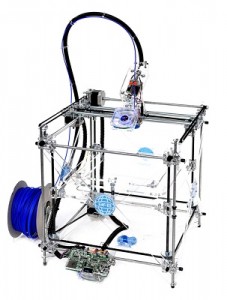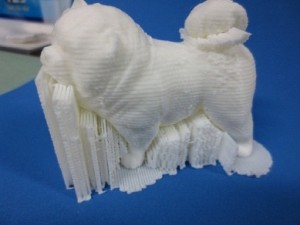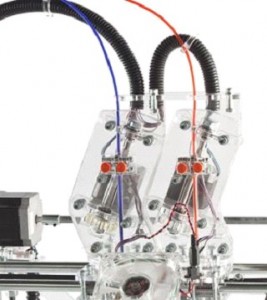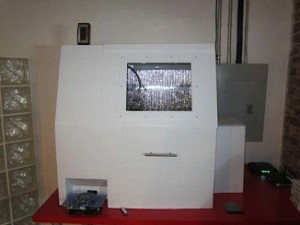The RapMan 3D printer is an all around personal 3D printing machine. Most 3D printers intended for home use utilize some off-shoot of the thermoplastic extrusion process. In the case of the RapMan, the process is called Additive Layer Manufacturing – ALM, and it doesn’t have any significant differences compared to the thermal plastic extrusion process.
The RapMan 3D printer uses ABS plastic and PLA filament for materials, and the cheapest kit available costs around $1400 USD.
Click here to check out the latest prices for the RapMan on Amazon right now!
What can you print with your RapMan 3D?
The RapMan 3D printer was designed for home and school use. It’s not a super-precise professional SLA machine, and neither it is a bulky German SLS monster like the EOS printers. The chief application of this printer seems to be the creation of various toys, models and functional items that don’t have particularly complex forms, precise dimensions, super-smooth surface or high levels of strength and endurance (after all, you are using plastic, not metal).
The printed part cannot be larger than 270 x 205 x 210 mm (XYZ) in size, and if you want it to have removable supports, you’ll have to get a double head kit – which means an increase in price and a decrease of the overall build volume. If you aren’t really concerned about the price and the build size, you might want to get the kit that lets you print in two colors and essentially with two different materials. The resolution is enough for home or modeling applications.
With these limitations in mind, you can print a ton of useful things if you use your imagination. To get your creativity going, you can check out the “Thingiverse” website, which hosts a bunch of designs that should be printable by the RapMan 3D printer. And the functional models aren’t limited to custom-printed boxes or cases – you can make all kinds of useful items, like a tablet stand or small steam engine. You can even print a musical instrument – an ocarina or a flute.
What materials can the RapMan use?
What you can print isn’t based only on the volume and accuracy. The materials are very important too. After all, you don’t want to spend hours designing a model just to find out it isn’t strong enough to be used as intended. Or imagine making a beautiful mug in the form of Fabio’s bust and then finding out it leaks toxins into your coffee when heated.
Fortunately, this wouldn’t happen with the RapMan, as this 3D printer uses ABS plastic and PLA filament as building materials (the default extruder uses a 3mm string of material). They’re both relatively non-toxic, for plastics. Those disposable plastic cups from the water cooler are sometimes made from PLA, and ABS is used as part of tattoo ink.
Buy the RapMan on Amazon here!
There are, however, some differences between PLA and ABS.
ABS plastic is an oil-based plastic that is good mechanically – it boasts good impact resistance, shock absorbance and toughness. It’s also more flexible than PLA, and can be bonded using both adhesives an solvents. However, it is more prone to warping, cracking and delamination than PLA and it shouldn’t stay out in the sun for too long. It should be used in conjunction with a polyimide tape as base to which it can adhere. The other important thing here is that ABS requires a heated bed or a heated chamber.
PLA, on the other hand, is plant-based (it’s made from vegetable waste), allows for finer detail and resolution, and generally has better-smelling fumes (this, however, varies with grades of plastics). It’s also more forgiving to the cold air – in fact, you might want to construct a special heated chamber for your printer if you decide to use ABS.
The moral here is that if you don’t need better mechanical properties of ABS plastics, you’re better off sticking to PLA, as the latter is more forgiving. In fact, if you don’t have super-strict requirements for the mechanical properties of the finished products, you won’t notice the difference between ABS and PLA. And since you’re using the RapMan, avoiding the hassles of building a heated chamber or a heated base and making sure the fumes have somewhere to go are definitely worth it.
Wait, fumes? Heated chamber? I thought this was a desktop printer!
It is a desktop printer, yes. And it’s remarkably home (or office) friendly, too. The fumes at the very worst smell bad, but they aren’t toxic. The heated chamber described? It isn’t necessary – just preferable if you’re using ABS. RapMan is also pretty quiet, and doesn’t need much juice – the power requirements are 60 Watts (5A @ 12V).
In fact, you don’t even need a computer to print. You can send files to be printed directly from your USB drive, meaning there will be no compatibility issues as long as you convert your STLs into a proper format beforehand. All kits come with BfB Axon 2 software package which allows you to do just that. And it doesn’t matter which OS you use – BfB Axon is built on Skeinforge,meaning you can run it on Windows, Mac OS X, and Linux/Unix.
Click here to check out the latest prices for the RapMan on Amazon right now!
The RapMan 3D printer is an inexpensive 3D printing option. However, it comes as a hobby kit, so not just some assembly is required. . . a whole lot of assembly is needed. But there’s plenty of help and resources available on the bitsfrombytes forums!
Be sure to check out the RapMan Resource page for a growing list of helpful RapMan resources!
Click here for more 3D printer reviews!
RapMan 3D Printer Specifications
| Technology: | FFF (Fused Filament Fabrication) aka TPE (Thermoplastic Extrusion) |
| Frame size (Width x Depth x Height): | ~ 19.2" x 20.4" x 32.2" |
| Weight: | ~ 37.5 lbs |
| Build materials: | PLA filament, ABS plastic |
| Accuracy: | Z axis: 0.125 mm |
| Build volume (X,Y,Z): | 10.6" x 8.1" x 8.3" |
| Price: | Starting at $1260 |
| Price of material: | $75 per 1 kg |





Comments are closed, but trackbacks and pingbacks are open.